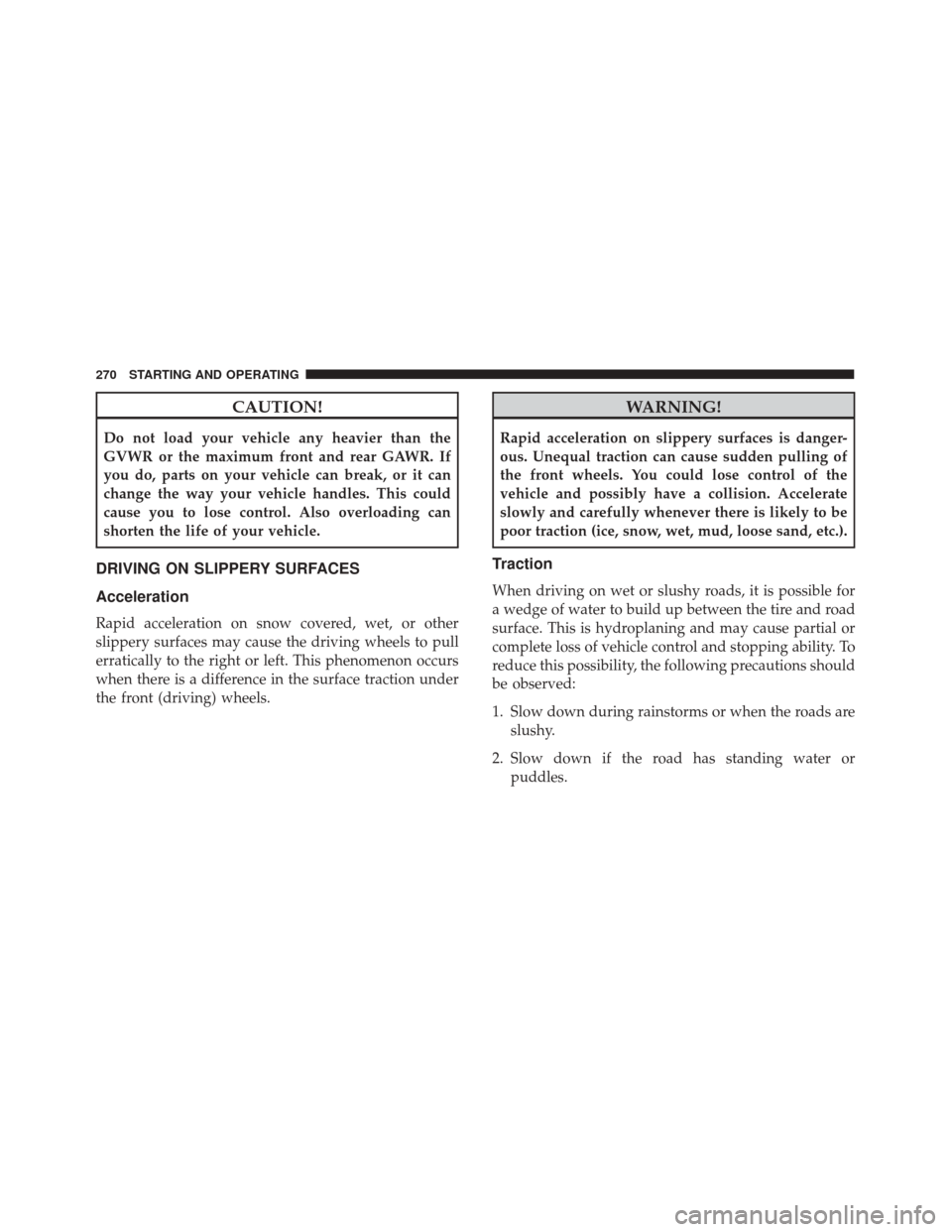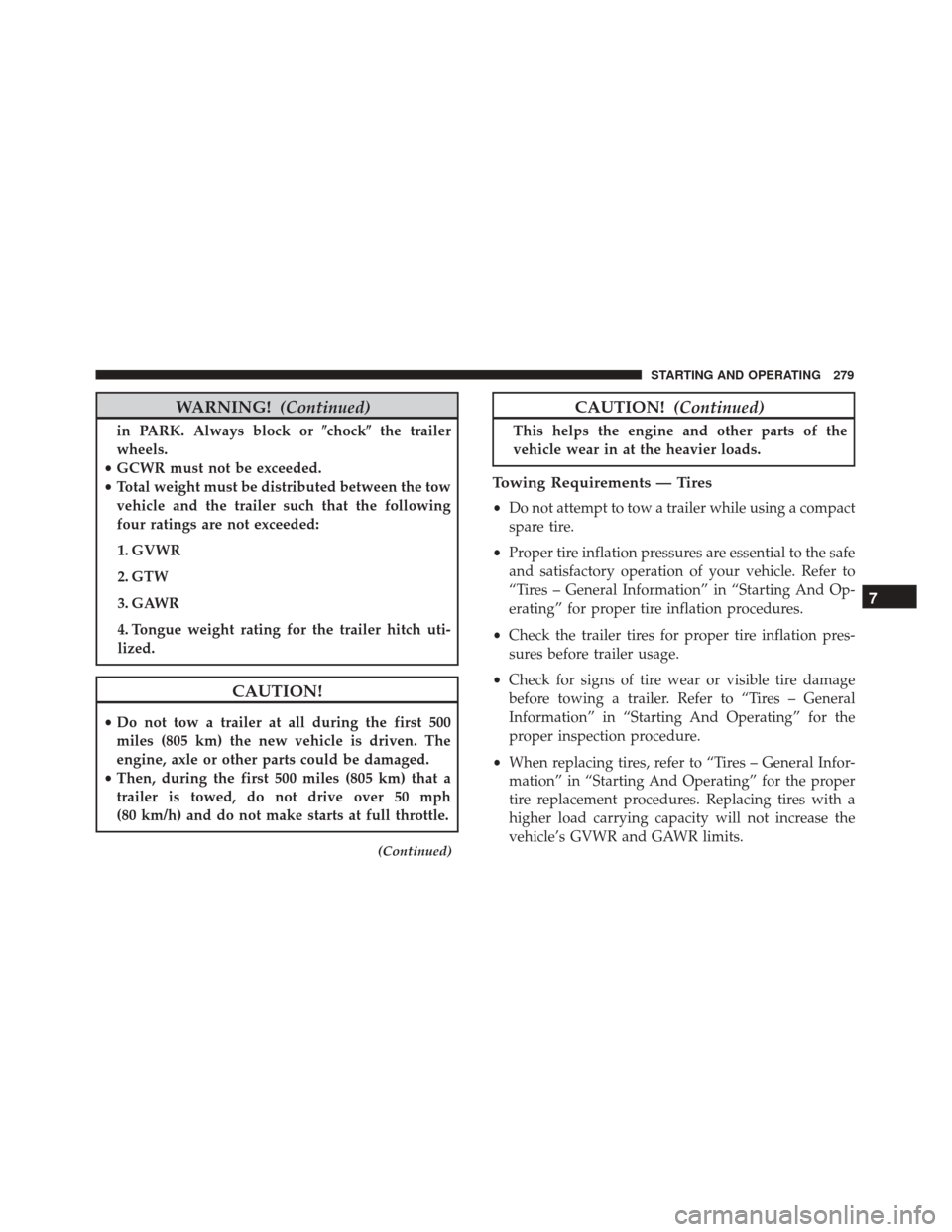Page 270 of 476

WARNING!
•Do not affix objects/plugs to the end of the filler
neck other than is provided on the car.
• The use of objects/plugs do not comply with the
vehicle and may cause pressure increases inside
the tank, creating dangerous conditions.
• Do not approach the neck of the tank with open
flames or lit cigarettes its an extreme fire hazard.
Also, avoid close contact with the filler pipe with
your face, do not inhale harmful vapors.
• Do not use your mobile phone in the vicinity of
the pump fuel nozzle, it can be a possible risk of
fire.
VEHICLE LOADING
Certification Label
As required by National Highway Traffic Safety Admin-
istration regulations, your vehicle has a certification
label affixed to the driver’s side door or pillar.
This label contains the month and year of manufacture,
Gross Vehicle Weight Rating (GVWR), Gross Axle
Weight Rating (GAWR) front and rear, and Vehicle
Identification Number (VIN). A Month-Day-Hour (MDH) number is included on this label and indicates
the Month, Day and Hour of manufacture. The bar code
that appears on the bottom of the label is your VIN.
Gross Vehicle Weight Rating (GVWR)
The GVWR is the total permissible weight of your
vehicle including driver, passengers, vehicle, options
and cargo. The label also specifies maximum capacities
of front and rear axle systems (GAWR). Total load must
be limited so GVWR and front and rear GAWR are not
exceeded.
Payload
The payload of a vehicle is defined as the allowable
load weight a truck can carry, including the weight of
the driver, all passengers, options and cargo.
Gross Axle Weight Rating (GAWR)
The GAWR is the maximum permissible load on the
front and rear axles. The load must be distributed in the
cargo area so that the GAWR of each axle is not
exceeded.
Each axle GAWR is determined by the components in
the system with the lowest load carrying capacity (axle,
springs, tires or wheels). Heavier axles or suspension
268 STARTING AND OPERATING
Page 272 of 476

CAUTION!
Do not load your vehicle any heavier than the
GVWR or the maximum front and rear GAWR. If
you do, parts on your vehicle can break, or it can
change the way your vehicle handles. This could
cause you to lose control. Also overloading can
shorten the life of your vehicle.
DRIVING ON SLIPPERY SURFACES
Acceleration
Rapid acceleration on snow covered, wet, or other
slippery surfaces may cause the driving wheels to pull
erratically to the right or left. This phenomenon occurs
when there is a difference in the surface traction under
the front (driving) wheels.
WARNING!
Rapid acceleration on slippery surfaces is danger-
ous. Unequal traction can cause sudden pulling of
the front wheels. You could lose control of the
vehicle and possibly have a collision. Accelerate
slowly and carefully whenever there is likely to be
poor traction (ice, snow, wet, mud, loose sand, etc.).
Traction
When driving on wet or slushy roads, it is possible for
a wedge of water to build up between the tire and road
surface. This is hydroplaning and may cause partial or
complete loss of vehicle control and stopping ability. To
reduce this possibility, the following precautions should
be observed:
1. Slow down during rainstorms or when the roads areslushy.
2. Slow down if the road has standing water or puddles.
270 STARTING AND OPERATING
Page 275 of 476

If the “SERVICE POWER STEERING�OR
�POWER STEERING ASSIST OFF - SERVICE
SYSTEM” message and a steering wheel icon
are displayed on the instrument cluster screen, it indi-
cates that the vehicle needs to be taken to the dealer for
service. It is likely the vehicle has lost power steering
assistance. Refer to “Instrument Cluster Display” in
“Getting To Know Your Instrument Panel” for further
information.
NOTE:
• Even if the power steering assistance is no longer
operational, it is still possible to steer the vehicle.
Under these conditions there will be a substantial
increase in steering effort, especially at low speeds
and during parking maneuvers.
• If the condition persists, see your authorized dealer
for service.
TRAILER TOWING
In this section you will find safety tips and information
on limits to the type of towing you can reasonably do
with your vehicle. Before towing a trailer, carefully
review this information to tow your load as efficiently
and safely as possible. To maintain the New Vehicle Limited Warranty cover-
age, follow the requirements and recommendations in
this manual concerning vehicles used for trailer towing.
Common Towing Definitions
The following trailer towing related definitions will
assist you in understanding the following information:
Gross Vehicle Weight Rating (GVWR)
The GVWR is the total allowable weight of your vehicle.
This includes driver, passengers, cargo and tongue
weight. The total load must be limited so that you do
not exceed the GVWR. Refer to “Vehicle Loading/
Vehicle Certification Label” in “Starting And Operat-
ing” for further information.
Gross Trailer Weight (GTW)
The GTW is the weight of the trailer plus the weight of
all cargo, consumables and equipment (permanent or
temporary) loaded in or on the trailer in its
�loaded and
ready for operation� condition.
The recommended way to measure GTW is to put your
fully loaded trailer on a vehicle scale. The entire weight
of the trailer must be supported by the scale.
7
STARTING AND OPERATING 273
Page 281 of 476

WARNING!(Continued)
in PARK. Always block or �chock�the trailer
wheels.
• GCWR must not be exceeded.
• Total weight must be distributed between the tow
vehicle and the trailer such that the following
four ratings are not exceeded:
1. GVWR
2. GTW
3. GAWR
4. Tongue weight rating for the trailer hitch uti-
lized.
CAUTION!
• Do not tow a trailer at all during the first 500
miles (805 km) the new vehicle is driven. The
engine, axle or other parts could be damaged.
• Then, during the first 500 miles (805 km) that a
trailer is towed, do not drive over 50 mph
(80 km/h) and do not make starts at full throttle.
(Continued)
CAUTION! (Continued)
This helps the engine and other parts of the
vehicle wear in at the heavier loads.
Towing Requirements — Tires
•Do not attempt to tow a trailer while using a compact
spare tire.
• Proper tire inflation pressures are essential to the safe
and satisfactory operation of your vehicle. Refer to
“Tires – General Information” in “Starting And Op-
erating” for proper tire inflation procedures.
• Check the trailer tires for proper tire inflation pres-
sures before trailer usage.
• Check for signs of tire wear or visible tire damage
before towing a trailer. Refer to “Tires – General
Information” in “Starting And Operating” for the
proper inspection procedure.
• When replacing tires, refer to “Tires – General Infor-
mation” in “Starting And Operating” for the proper
tire replacement procedures. Replacing tires with a
higher load carrying capacity will not increase the
vehicle’s GVWR and GAWR limits.
7
STARTING AND OPERATING 279
Page 286 of 476
Highway Driving
Reduce speed.Air Conditioning
Turn off temporarily.
RECREATIONAL TOWING (BEHIND MOTORHOME, ETC.)
Towing This Vehicle Behind Another Vehicle
TOWING CONDITION
WHEELS OFF THE
GROUND FRONT WHEEL DRIVE
(FWD) ALL-WHEEL DRIVE
(AWD)
Flat Tow NONENOT ALLOWED NOT ALLOWED
Dolly Tow REARNOT ALLOWED NOT ALLOWED
FRONT OKNOT ALLOWED
On Trailer ALLBEST METHOD OK
NOTE: When towing your vehicle, always follow applicable state and provincial laws. Contact state and pro-
vincial Highway Safety offices for additional details.
NOTE: You must ensure that the Auto Park Brake
feature is disabled before towing this vehicle, to avoid
inadvertent Electric Park Brake engagement. The Auto
Park Brake feature is enabled or disabled via the
Customer Programmable Features in the Uconnect Set-
tings.
284 STARTING AND OPERATING
Page 287 of 476

Recreational Towing
Front-Wheel Drive (FWD) Models
Recreational towing is allowed ONLY if the front
wheels are OFF the ground. This may be accomplished
using a tow dolly (front wheels off the ground) or
vehicle trailer (all four wheels off the ground). If using
a tow dolly, follow this procedure:
•Properly secure the dolly to the tow vehicle, follow-
ing the dolly manufacturer’s instructions.
• Drive the front wheels onto the tow dolly.
• Apply the Electric Park Brake (EPB). Place the trans-
mission in PARK. Turn the engine OFF.
• Properly secure the front wheels to the dolly, follow-
ing the dolly manufacturer’s instructions.
• Cycle the ignition to the RUN mode, but do not start
the engine.
• Press and hold the brake pedal. •
Release the Electric Park Brake (EPB).
• Cycle the ignition OFF, remove the key fob, and
release the brake pedal.
CAUTION!
• DO NOT flat tow this vehicle. Damage to the
drivetrain will result. If this vehicle requires
towing, make sure the drive wheels are OFF the
ground.
• Ensure that the Electric Park Brake is released,
and remains released, while being towed.
• Towing this vehicle in violation of the above
requirements can cause severe transmission dam-
age. Damage from improper towing is not covered
under the New Vehicle Limited Warranty.
7
STARTING AND OPERATING 285
Page 288 of 476
All-Wheel Drive (AWD) Models
Recreational towing (with all four wheels on the
ground, or using a towing dolly) is NOT ALLOWED.
This vehicle may be towed on a flatbed or vehicle trailer
provided all four wheels are OFF the ground.CAUTION!
Towing this vehicle with ANY of its wheels on the
ground can cause severe transmission and/or power
transfer unit damage. Damage from improper tow-
ing is not covered under the New Vehicle Limited
Warranty.
286 STARTING AND OPERATING
Page 290 of 476
�TOWING A DISABLED VEHICLE ..........334
▫ Front Wheel Drive (FWD) Models .........335
▫ All Wheel Drive (AWD) Models ..........335
� TOW EYE USAGE — IF EQUIPPED .........336
▫ Front Tow Eye Installation ..............338 ▫
Rear Tow Eye Installation ...............339
� ENHANCED ACCIDENT RESPONSE SYSTEM
(EARS) ............................ .340
� EVENT DATA RECORDER (EDR) ..........340
288 IN CASE OF EMERGENCY